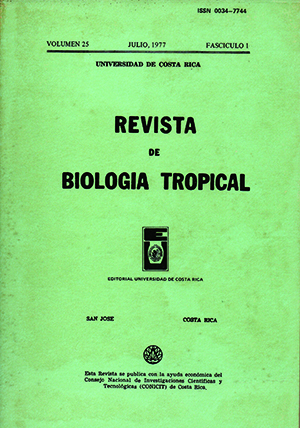Resumen
Los nidos de la abeja neo tropical Exomalopsis globosa se diferencian de los de E. similis por la presencia de una segunda entrada, por el ángulo de los ejes longitudinales de las celdillas, y también por el tipo de tierra debajo de ellos. En ambas especies hay dos o tres hembras que empiezan a construir un nido y la mayoría de las hembras que emergen quedan asociadas con sus nidos natales. Las hembras adultas ayudan en la hechura de los nidos y probablemente no todas producen huevos. La mortalidad durante el desarrollo fue mayor en los nidos más grandes de E. globosa que en los más pequeños. Se supone que varias hembras adultas habitan cada nido, reduciendo así los peligros a que estarían expuestas al salir en busca de otros sitios en donde fundar nuevas colonias.Citas
Batra, S. W. T. 1968. Behavior of some social and solitary halictine bees within their nests: a comparative study (Hymenoptera: Halictidae). J. Kans. Entomol. Soc., 41: 120-123.
Dalmau, A. 1970. Catálogo de los himenópteros de Cuba. Instituto Cubano del Libro, La Habana, 218 p.
Danks, H. V. 1971a. Biology of some stem-nesting aculeate Hymenoptera. Trans. R. Entomol. Soc. Lond., 122: 323-399.
Danks, H. V. 1971b. Nest mortality factors in stem-nesting aculeate Hymenoptera. J. Anim. Ecol., 40: 79-82.
Freeman, B. E. 1973. Preliminary studies on the population dynamics of Sceliphron assimile Dahlbom (Hymenoptera: Sphecidae) in Jamaica. J. Anim. Ecol., 42: 173-182.
Freeman, B. E., & D. B. Jayasingh 1975. Factors controlling the distribution in Jamaica of Pachodynerus nasidens (Latr.) (Hymenoptera; Eumenidae). Biol. J. Linn. Soc., 7: 231-241.
Gerber, H. S., & E. C. Klostermeyer 1970. Sex control by bees: a voluntary act of egg fertilization during oviposition. Science, 167: 82-84.
Hicks, C. H. 1936. Nesting habits. of certain western bees. Can. Entomol., 68: 47-52.
Linsley, E. G., J. W. MacSwain, & R. F. Smith 1954. A note on the nesting habits of Exomalopsis solani (Cockerell). Pan-Pacif Entomol., 30: 263-264.
Michener, C. D. 1954. Bees of Panama. Bull. Amer. Mus. Nat. Hist., 104: 1-175.
Michener, C. D. 1964. Reproductive efficiency in relation to colony size in hymenopterous societies. Insectes sociaux, 11: 317-342.
Michener, C. D. 1966. Evidence of co-operative provisioning of cells in Exomalopsis. J. Kans. Entomol., Soc., 39 : 315-317.
Michener, C. D. 1974. The sol:ial behaviour of the bees. Havard Univ. Press, Cambridge, Mass. 408 p.
Mitchell, T. B. 1962. Bees of the eastern United States. Tech. Bull. N. C. Agric. Sta. (152),1-557.
Raw, A. 1972. The biology of the solitary bee Osmia rufa (L) (Megachilidae). Trans. R.Entomol. Soc. Lond., 124: 213-229.
Raw, A. 1976. Seasonal changes in the numbers and foraging activities of two Jamaican Exomalopsis species (Hymenoptera, Anthophoridae). Biotropica, 8: 270-277.
Richards, O. W. 1949. The significance of the number of wing-hooks in bees and wasps. Proc. R Entomol. Soc. Lond., (A), 124: 75-78.
Rozen, J. G., & c. D MacNeill 1957. Biological observations on Exomalopsis (Anthophorula) chionura Cockerell, including a comparison of the biology of Exomalopsis with that of other anthophorid groups (Hymenoptera: Apoidea). Ann. Entomol. Soc. Amer., 50: 522-529.
Southwood, T. R. E. 1966. Ecological methods. Methuen, London. 391 p.
Spradbery, J. P. 1973. Wasps. Sidgwick and J ackson, London. 408 p.
Wolcott, G.N. 1948. The insects of Puerto Rico (Hymenoptera). J. P. Rico Insul. Agric. Exp. Sta., 32: 749-873.
Comentarios

Esta obra está bajo una licencia internacional Creative Commons Atribución 4.0.
Derechos de autor 1977 Revista de Biología Tropical


